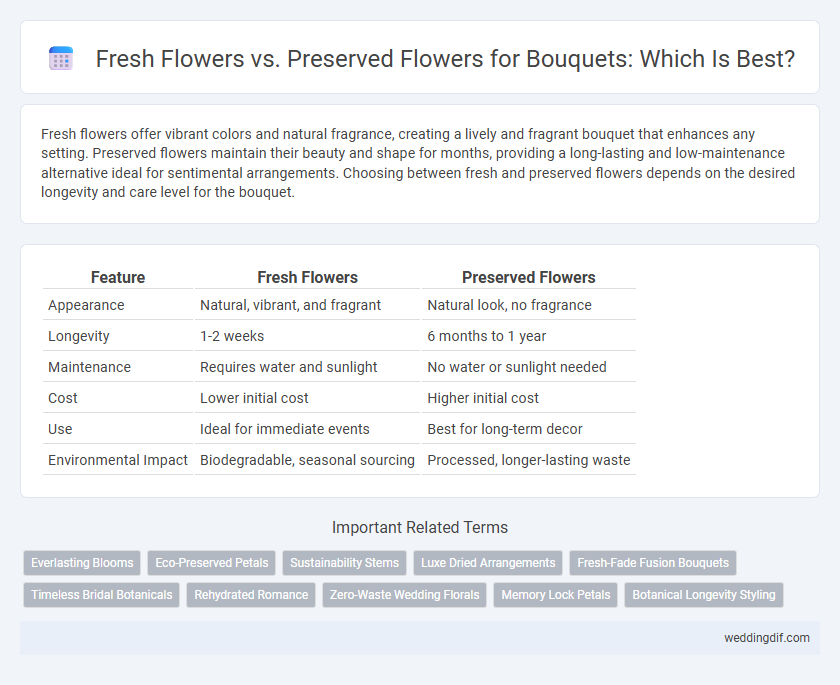Fresh flowers offer vibrant colors and natural fragrance, creating a lively and fragrant bouquet that enhances any setting. Preserved flowers maintain their beauty and shape for months, providing a long-lasting and low-maintenance alternative ideal for sentimental arrangements. Choosing between fresh and preserved flowers depends on the desired longevity and care level for the bouquet.
Table of Comparison
| Feature | Fresh Flowers | Preserved Flowers |
|---|---|---|
| Appearance | Natural, vibrant, and fragrant | Natural look, no fragrance |
| Longevity | 1-2 weeks | 6 months to 1 year |
| Maintenance | Requires water and sunlight | No water or sunlight needed |
| Cost | Lower initial cost | Higher initial cost |
| Use | Ideal for immediate events | Best for long-term decor |
| Environmental Impact | Biodegradable, seasonal sourcing | Processed, longer-lasting waste |
Fresh Flowers vs Preserved Flowers: An Overview
Fresh flowers offer vibrant colors and natural fragrance, making them a popular choice for bouquets in weddings and special events. Preserved flowers, treated with glycerin or silica gel, maintain their appearance and texture for months without wilting, providing long-lasting floral decor. Choosing between fresh and preserved flowers depends on the desired longevity, maintenance needs, and budget considerations for floral arrangements.
Aesthetic Qualities: Vibrancy and Texture
Fresh flowers offer unparalleled vibrancy and natural texture, showcasing rich colors and soft, delicate petals that enhance bouquet aesthetics. Preserved flowers maintain their form and color over time, providing consistent texture and a slightly muted yet elegant vibrancy ideal for long-lasting arrangements. Choosing between fresh and preserved flowers depends on the desired visual impact and longevity of the bouquet's aesthetic qualities.
Scent and Sensory Experience
Fresh flowers emit a natural, vibrant fragrance that enhances the sensory experience, creating an authentic and immersive floral aroma. Preserved flowers, while visually striking and long-lasting, typically lack the natural scent, relying instead on their appearance to evoke sensory appeal. For those prioritizing fragrance, fresh flowers remain the ideal choice to fully engage the senses in a bouquet.
Longevity and Durability of Bouquets
Fresh flowers offer a vibrant and natural appearance but typically last only 5 to 7 days, requiring careful watering and maintenance to maximize their longevity. Preserved flowers undergo a special treatment that can extend their lifespan up to several months or even years without the need for water, making them highly durable for long-lasting bouquets. The choice between fresh and preserved flowers depends on the desired durability and maintenance commitment for the bouquet.
Seasonal Availability and Selection
Fresh flowers offer a wide variety of seasonal blooms that reflect the natural growth cycles, providing vibrant colors and fragrances unique to each time of year. Preserved flowers, treated to maintain their appearance for months, allow for year-round availability regardless of natural seasonality but may limit selection to specific flower types suitable for preservation. Choosing between fresh and preserved flowers depends on the desired bouquet's seasonal authenticity versus longevity and consistent availability.
Eco-Friendliness and Sustainability
Fresh flowers offer a biodegradable option that naturally decomposes, reducing environmental impact and supporting sustainable gardening practices when sourced locally and grown without pesticides. Preserved flowers, treated to maintain their appearance for months or years, minimize waste by extending the bouquet's lifespan, though their chemical treatment and packaging can pose ecological concerns. Choosing eco-friendly bouquets involves balancing fresh flowers' renewable qualities with preserved flowers' longevity, prioritizing sources committed to sustainable cultivation and minimal ecological footprint.
Cost Comparison: Fresh vs Preserved
Fresh flower bouquets generally have a lower upfront cost but require frequent replacement due to their limited lifespan, making them more expensive over time. Preserved flower bouquets involve a higher initial investment but maintain their appearance for months or even years without additional care. Considering long-term expenses, preserved flowers offer better value for enduring beauty with minimal maintenance.
Maintenance and Care Requirements
Fresh flowers in bouquets require regular watering, precise temperature control, and timely trimming of stems to extend their vase life, typically lasting up to a week. Preserved flowers, treated with a special solution to maintain their natural appearance, demand minimal care without the need for water or sunlight, often lasting several months to years. The low-maintenance nature of preserved flowers makes them an ideal choice for long-lasting floral arrangements with minimal upkeep.
Customization and Versatility Options
Fresh flowers offer extensive customization through a wide variety of colors, scents, and seasonal blooms, allowing tailored arrangements for specific events or themes. Preserved flowers provide versatility by maintaining their appearance for months, enabling creative usage in long-lasting bouquets and mixed-media designs without wilting. Both options cater to different preferences, with fresh flowers excelling in vibrant spontaneity and preserved flowers excelling in enduring aesthetic appeal.
Best Occasions for Fresh or Preserved Flowers
Fresh flowers are ideal for vibrant occasions such as weddings, birthdays, and anniversaries, where their natural fragrance and bright colors enhance the celebratory atmosphere. Preserved flowers suit long-lasting displays like home decor, memorials, and corporate events, offering a maintenance-free option that retains beauty for months. Choosing between fresh and preserved flowers depends on the event's duration and desired aesthetic impact.
Fresh flowers vs preserved flowers for bouquets. Infographic

 weddingdif.com
weddingdif.com